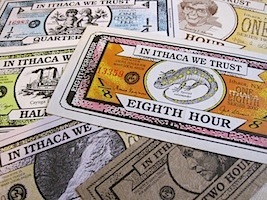




 |
 |
 |
 |
 |
The Multiplier Effect of HOURS December 1998 |
| by Monica Hargraves The "multiplier effect" of local currencies refers most specifically to the fact that a given amount of local currency changes hands numerous times in the course of a year. So you can convert the known quantity of the stock of currency in circulation at a point in time into a number that measures the value of the total transactions the currency has played a role in. In Ithaca, for example, we have about 6,700 HOURS in circulation at the moment. A study by a grad student at Cornell estimated the yearly HOURS multiplier at 6, so we can estimate that 40,200 HOURS worth of trades, or $402,000 worth of trades take place in HOURS in a year. Paul Glover estimates up to $700,000 yearly. As for how to construct the estimate for a local currency system in general -- I am not sure how the Ithaca HOURS study was done (I will be getting a copy of it from Paul so I may be able to write more later), but I imagine that it relies at least in part on survey evidence that measures how many times a given piece of currency changes hands. One of the Hour Town cover stories a while ago (actually Feb-Mar '96, back when the paper was called "Ithaca Money") showed a great cartoon that traced the actual exchanges that took place from the time one HOUR was created through five months of its life [on this website in the Publicity section]. There are 24 trades records there -- presumably a faster rate of turnover ("velocity") than average, but a real-life sequence of trades. Surveys of participants that ask how often they have earned and spent HOURS in the past month or two months would be one way of getting a handle on this velocity in general. Tracing the trading history of a certain number of pieces of currency would be trickier, but would give a better estimate of turnover. Of course actual turnover rates vary a lot, so you'd have to track quite a lot of currency to get a good idea of the average. One idea we have been talking about recently in Advisory Board meetings in Ithaca is that if people only have a small amount of HOURS on hand, they tend to hold onto them rather than spend them. In contrast, people with a big stack of HOURS on hand tend to be more energetic and creative about finding ways to spend them. What this means is that velocity, or turnover, might actually slow down if the stock of HOURS is spread thinly among the community. The reason it matters for the Board is of course that we need to think about whether there is "enough" currency in circulation. Comments from some local retail participants seems to be indicating that they are seeing fewer HOURS than they used to , and we are speculating that |
part
of the reason is that HOURS are now actually quite widely, and so quite
thinly, spread around. We're still mulling this over. A common question that arises when people inquire about the impact of local currencies is how to distinguish between trades that ONLY took place because of the local currency system, and trades that would have taken place anyway but in which local currencies were used -- that is, how much of the trading is "new" and how much would have happened anyway in dollars. This is very hard to quantify. There is absolutely no doubt that lots of new trades, and therefore new incomes, are made possible by the existence of the local currency system. This happens in lots of indirect ways -- the sheer existence of the system and its newpaper tend to encourage people to think creatively about what they are good at or what they like to do outside the "box" of a standard resume format. So people are encouraged to experiment and think more broadly. Then there's the added angle of reducing what I think of as "barriers to entry" -- having a local currency paper and therefore an inexpensive way of spreading the word in the commmunity about what you do makes it a lot easier for people with ideas and time and talent to actually get going and make things or provide services and earn income. These too are trades that would not have taken place without the local currency system. And then even for people already in business -- all the individuals that earn money they would not otherwise have earned, and the businesses that get customers they would not have had, also represent trades that would not have happened with just a dollar system. Finally, there's the barter category: to the extent that the currency facilitates what would otherwise have been a barter exchange (because two people don't have to match their needs and wants, but can use local money and then go off and find other suppliers of what they want and pay with HOURS) there are even more trades taking place that would not have happened if the only trading mechanisms available were dollars or barter. I don't know how to measure these fractions of trades exactly. I guess that over time the managers of the system develop a feel for what portion of trades might have happened anyway, and what portion is due purely to the currency system. I would tend to think that the fraction that would have happened in dollars anyway is quite small. Monica Hargraves was a member of the Ithaca HOURS Board. She is a former professor of economics at Brown University, former executive of the International Monetary Fund, and former researcher for the Federal Reserve. She currently (2011) works at Cornell Cooperative Extension, researching Systems Evaluation Protocol (SEP) and the Netway cyber-infrastructure that supports it. |